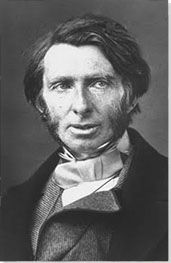Summary of John Ruskin
An incredibly influential figure, who inspired people as diverse as Mahatma Ghandi, Leo Tolstoy, and Dante Gabriel Rossetti, Ruskin was a complex, intense, and incredibly articulate man. Although he is best known as an art critic and patron, he was a true polymath and was also a talented watercolorist, an engaging teacher, a respected geologist, and a campaigner for social and political change. The importance of nature, God, and society are reoccurring themes throughout his work and these driving forces formed the tenets of his forward-thinking beliefs. He was an advocate for new styles of painting, the protection of historic buildings, the conservation of natural landscapes, the education of women, and the improvement of conditions for the working classes. He also identified risks associated with the Industrial Revolution, such as pollution, many years before they were widely acknowledged. His writings and the ideas in them brought new artists to prominence, encouraged the formation of the National Trust, and helped to protect the architecture of Venice. His views also helped to shape welfare reforms in Britain such as the introduction of a minimum wage, free school meals, and universal healthcare.
Accomplishments
- Ruskin was an incredibly prolific writer, publishing more than 50 books on a huge range of topics from art criticism to fiction and political treatises to travel guides. It was through these writings (which included lecture transcripts and letters as well as more conventional essays) that he communicated his innovative ideas and over the course of his career, he simplified his writing style to make them as accessible to as many people as possible.
- As art critic, Ruskin championed the idea of "truth to nature" which encouraged painters to closely observe the landscape and in doing so capture the natural world as truthfully as possible, not romanticizing what they saw. This idea was hugely influential on the Pre-Raphaelite Brotherhood, a group of young artists who rejected contemporary notions of artistic beauty and instead sought to produce a pre-Renaissance style of painting. Ruskin's emphasis on the natural (along with his dislike of mass production) also had an impact on the development of the Arts and Crafts Movement.
- Ruskin was an avid promoter of Gothic architecture and his writing influenced a widespread return from Neoclassicism to the earlier Gothic style. His work inspired architects including Le Corbusier, Frank Lloyd Wright, and Walter Gropius and his ideas are said to have been influential in the foundation of the Garden City Movement.
- Ruskin's religious upbringing continued to have an impact on his ideas and he believed that nature and beauty were inextricably bound up with concepts of the divine. He consequently argued that the best way to portray faith, was not through epic religious scenes, but through the understanding and faithful depiction of nature and the human body. This was taken to heart by the Pre-Raphaelite who attempted to harmoniously incorporate religious devotion into their work. This led to censure when developing this idea, they depicted religious figures as normal members of the working classes, with dirty clothes and fingernails instead of idealizing them.
John Ruskin and Important Artists and Artworks
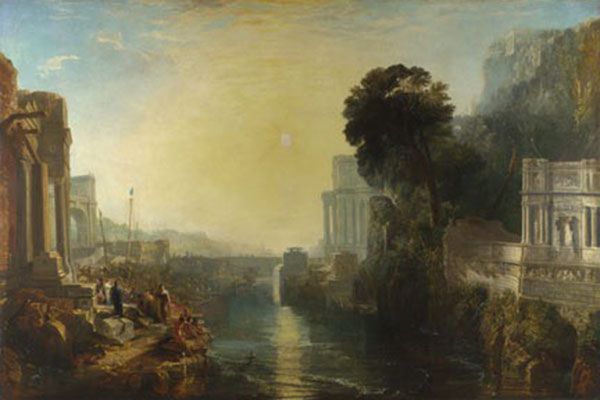
Dido building Carthage, or The Rise of the Carthaginian Empire (1815)
This was one of ten paintings produced by Turner depicting the subject of the Carthaginian empire. Inspired by Virgil's The Aeneid, the composition shows Dido on the far left in blue robes. She is visiting her husband Sychaeus' tomb. The figure in front of her is likely to be Aeneas, a future love interest. Turner modelled the composition and style closely on the work of the well-known 17th century landscape painter Claude Lorrain, notably his Seaport with the Embarkation of the Queen of Sheba (1648). According to Ruskin, however, Turner surpassed the Frenchman, writing that "Claude possesses some species of sterling excellence, but it follows not that he may not be excelled by Turner."
Turner and Ruskin had a close, if complex relationship. The pair met when Ruskin's affluent father (John Ruskin senior) began to commission watercolors from the painter. Ruskin became fascinated with these works and penned his first defense of Turner when he was just 16 (although this was not published). As a result, he was invited to watch Turner paint, and the pair discussed art, with Turner asking the young critic's opinion, despite the fact that he was 30 years his junior. As a result and, in contrast to popular and critical opinion, Ruskin vehemently defended Turner in Modern Painters (1843), describing him as the "greatest of all landscape painters".
By Turner's death in 1851, however, the pair had fallen out with Ruskin describing Turner's 1846 painting Angel Standing in the Sun as being "indicative of mental disease". Nevertheless, Ruskin's writing had a profound effect on Turner's success. As art historian Daisy Dunn writes: "Had it not been for Ruskin it is questionable whether Turner's art would be so popular today...Although Ruskin feared that public opinion had been permanently tainted by the critics, his words found an appreciative public."
Oil on canvas - The National Gallery, London
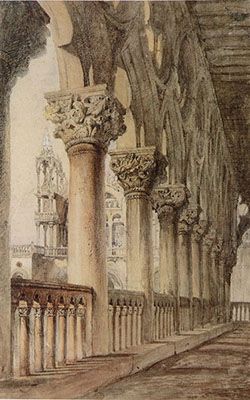
Loggia of the Ducal Palace, Venice (1849-50)
Ruskin's sketches and paintings of Venice were considered among his best, and although he never called himself an artist, an examination of this work gives a good understanding of his ideas. In this watercolor, he carefully studied the decorative columns of Venice's most famous Gothic loggia (a covered exterior gallery), as well as showing Saint Mark's Basilica in the distance. The watercolor demonstrates his talents as a draftsman and his skilled understanding of perspective and composition. Ruskin articulated his style and painterly processes in his 1857 work Elements of Drawing, in which he advocated close observation of nature. Its reach was such that Claude Monet said in 1900 that "ninety per cent of the theory of Impressionist painting is in...Elements of Drawing."
Ruskin called the Ducal Palace "the central building of the world" and for him, Venice represented spiritual purity. He believed that the intricacies and ornate designs of Gothic architecture were far superior to that of the subsequent Renaissance because they represented emotion and reverence for God. He said that Renaissance architects created for their own glory, while Gothic architects created for the glory of God, and that the Gothic style expressed man's humility in the face of the divine. He argued that the loss of Gothic architecture represented a loss of something deeply spiritual in Western society and the growth of a Pagan ethos.
Ruskin's writings were responsible for the eventual Gothic revival and his books and drawings of Venice in particular were integral to securing the city's conservation. As art historian Daisy Dunn records: "Ruskin's publications sparked fresh interest in Italian art and particularly Venetian Gothic architecture. He made numerous prints and drawings, fearing that, if he did not, Venice might vanish undocumented like 'a lump of sugar in hot tea'." Ruskin's writings also influenced later architects, including the young Le Corbusier, whose early work demonstrates many of Ruskin's key principles. Frank Lloyd Wright's belief in the natural can also be seen as a result of Ruskin's influence and his skyscraper designs are based on the structural forms of trees.
Watercolor over graphite - The Met, New York

Convent Thoughts (1850-51)
This brightly colored oil canvas shows a nun deep in thought standing in a walled garden. She holds in her left hand a book showing a religious illustration, but it has been dropped to her side as she contemplates a passion flower - symbolic of Christ's crucifixion. The painting is executed in the minutely-detailed style of the early Pre-Raphaelites and the frame, designed by Millais, is inscribed with the words Sicit Lilium ("As the lily among thorns"), a quote taken from the Song of Solomon. The painting was exhibited at The Royal Academy in 1851.
Charles Allston Collins is one of the lesser known of the Pre-Raphaelites (he was never a member of the brotherhood) but this work was nonetheless singled out by Ruskin in a letter to The Times. Ruskin commended the paintings of all the Pre-Raphaelites in the Academy exhibition, but noted particularly the botanical studies present in this image. Using this work as an example, Ruskin encouraged artists not to represent God with religious pictures, but with the natural world instead. The Pre-Raphaelites took these ideas to heart, producing a stream of art that depicted detailed and celebratory images of nature and the human body. These lessons were also taken up in America where artists at the frontier began to produce epic images of the great American West.
Ashmolean Museum, Oxford, UK
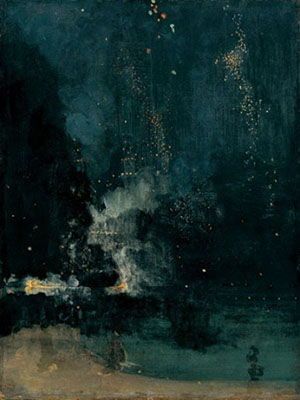
Nocturne in Black and Gold: The Falling Rocket (1875)
Just as Ruskin had the power to build artists up, he could destroy them too. His fierce criticism of JAM Whistler caused him to instigate a court case that ultimately bankrupted him. This is one of six Nocturnes that the American artist painted depicting Cremorne Gardens in London. Much of the canvas depicts the night sky illuminated by fireworks, with the foggy night sky mixing with the billowing smoke of the fireworks. The foreground shows the banks of the River Thames, on which stand ghostlike figures, their transparency adding to the mystery of the work.
Ruskin hated it. He accused Whistler of stealing Turner's style and decried the fact that he was painting the seedier side of London. Ruskin saw industrial pollution as symptomatic of moral degeneracy and this painting as an affront. When the painting was put up for sale in 1877, Ruskin wrote: "I have seen, and heard, much of Cockney impudence before now; but never expected to hear a coxcomb ask two hundred guineas for flinging a pot of paint in the public's face." Whistler sued Ruskin for libel. In the court room he was asked if he thought the two days' labour he spent on Nocturne was worth the 200 guinea price tag. To applause he replied: "No. I ask it for the knowledge of a lifetime." Whistler won, but was awarded just a farthing in damages. The costs of the case financially ruined him, but the injury was not limited to Whistler. Ruskin's own inability to adapt to new styles damaged his reputation as a critic and many dismissed him as out of date; an enemy of modern art.
Oil on panel - The Detroit Institute of Arts, Detroit, USA
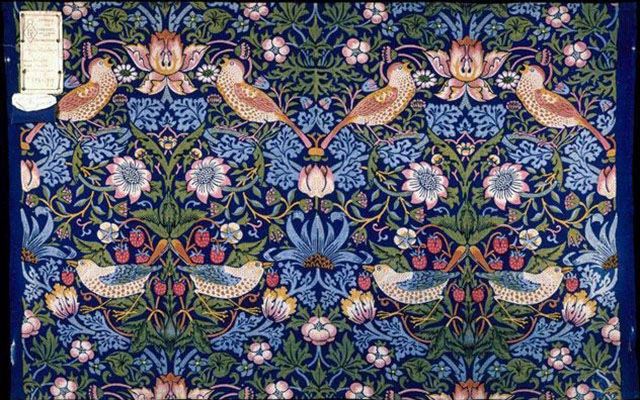
The Strawberry Thief (1883)
This textile design is one of William Morris' most famous and the pattern shows the thrushes that stole the fruit from the garden of his Oxfordshire home. The fabric was printed by the indigo discharge method, an ancient and complex technique used for many centuries in the East. The intricate and stylized design reflects the aesthetics of Medieval revivalism to which Morris and the Arts and Crafts Movement were closely aligned.
Morris discovered Ruskin's writings at university and became a devoted follower of his work. The men had a lot in common; Morris revered nature and motifs of flowers, leaves and birds proliferated in his designs. They were also both appalled by the industrial revolution and its consequences - mass production, unimaginative architecture, and a decline in artisanship. They advocated a return to craftsmanship, leading to the advent of the Arts and Crafts movement which, in turn, influenced many of the principles of Art Nouveau. As art historian E. H. Gombrich wrote: "Men like Morris and Ruskin dreamt of a thorough reform of the arts and crafts, and the replacement of cheap mass-production by conscientious and meaningful handiwork. The influence of their criticism was very widespread even though the humble handicrafts which they advocated proved, under modern conditions, to be the greatest of luxuries." This is exemplified by this fabric, which due to its artisan production techniques would have been prohibitively expensive for most people.
Furniture fabric - The Victoria and Albert Museum, London

The Three Tetons (1881)
Ruskin's influence also stretched across the Atlantic to artists in the United States. The American Landscape Painter Thomas Moran was heavily influenced by Ruskinian thought and sought to reproduce the divine in his epic paintings. In this work, his subject was the distinctive Three Tetons, the principle summits of the Wyoming Range. Inspired by Ruskin's teachings, Moran sought to follow the concept of "truth to nature" which proposed that the artist had a fundamental role connecting nature and society, and to do so he went on dangerous and challenging journeys to produce epic canvases that depicted the Grand Canyon and the Rocky Mountains. Moran learned from Turner's paintings and following Ruskin's advice, made it his mission to "study nature carefully and reproduce her wonders accurately". Moran had been inspired by Modern Painters, and believed God was to be found in American topography.
In turn Ruskin was a big fan, and he wrote many admiring letters to Moran and brought his work to add to his private collection. Ruskin wrote: "[n]or are there any descriptions of the Valley of Diamonds, or the Lake of the Black Islands, in the 'Arabian Nights,' anything like so wonderful as the scenes of California and the Rocky Mountains which you may ... see represented with most sincere and passionate enthusiasm by the American landscape painter, Mr Thomas Moran." By the 1850s, Ruskin had more readers in America than he did in England and his theories helped to unify artists as art historian Joni Louise Kinsey notes: "Indeed, it was Ruskin's conjunction of art with morality, religion and nature that for a time, at about mid-century, brought a number of disparate trends in American aesthetics together into something approaching a consensus, artistically and nationalistically."
Oil on board - The Gilcrease Museum, Tulsa, USA
Biography of John Ruskin
Childhood and Early Life
An only child, Ruskin was born in 1819 in south London to affluent parents, John James Ruskin, a Scottish wine merchant, and Margaret Ruskin, the daughter of a pub proprietor. The young Ruskin spent his summers in the Scottish countryside and when he was four, the family moved to south London's Herne Hill, a rural area at the time. It was these early experiences that ignited his lifelong love of nature. He was educated at home, where he was influenced by his father's collection of watercolors and his mother's pious Protestantism. Ruskin recalled a rigorous daily practice of bible reading and interpretation, which was to provide an early foundation for his work in criticism. At the age of seven he began to write books and his father - ambitious for his son to find success - would pay him for his poems.
The family's wealth allowed them to travel extensively throughout the UK and Europe, visiting Italy, France, and Belgium. Ruskin was particularly taken by the picturesque landscape of the Lake District and his first publication was a poem entitled On Skiddaw and Derwent Water which appeared in the Spiritual Times in 1829. He also became fascinated by the Romantic poets Wordsworth, Byron, and Scott. Ruskin was an intelligent and articulate teenager. He collected and compiled a dictionary of minerals and he had three articles on geology published in the Magazine of Natural History when he was 15. He went on to study classics at Oxford University, where his mother followed him, insisting that she meet him for tea every day. He did well at university, but after a period of illness, he left in 1842, with only a double fourth degree (a classification lower than a third, awarded by Oxford until 1971) in classics and mathematics.
Mature Period
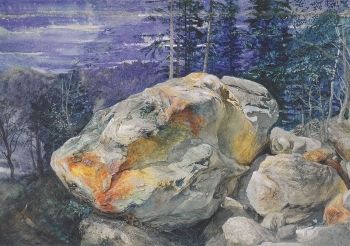
It is often forgotten that Ruskin was a talented artist in his own right, and he said the instinct he had to draw was akin to the instinct to eat and drink. He filled sketchbooks from an early age, and throughout his life produced volumes of exquisite sketches and watercolors of nature; blossoms, flowers, mountains, stones, clouds, minerals, and birds. His watercolors mimicked J.M.W. Turner's expressive style and he was most prolific in the period 1840-70, with fewer produced later in his life. He did not, however, exhibit his artwork professionally, instead he used his studies to record what he saw and assist with his writing. Although many of his images were never shared, he used some to illustrate his essays and books.
Modern Painters (1843)
When Ruskin was 24, he wrote the first volume of Modern Painters - Their Superiority in the Art of Landscape Painting to All the Ancient Masters, a hugely influential work that launched an assault on the artistic establishment. The book criticized the work of 17th century painters such as Claude Lorrain, Nicolas Poussin, and Salvator Rosa. As an alternative, Ruskin promoted the accurate documentation of nature and he especially championed J.M.W. Turner, who was a controversial figure in the establishment at the time. Modern Painters questioned the arguments of Sir Joshua Reynolds and the rules which he had established at the Royal Academy. Many were appalled, but the passion with which Ruskin wrote won him fans and he was championed as a new voice in modern artistic thinking. He particularly found favor with contemporary writers of the time, including William Wordsworth, George Elliot, and Charlotte Brontë as well as with the Pre-Raphaelite Brotherhood. Ruskin went on to publish four more volumes, with the last coming out in 1860. Modern Painters also found an eager readership in America, where artists felt it freed them. As artist John A. Parks said: "Art could now become both an aesthetic and a religious quest freed from the dominance of centuries of European painting. This was the magic brew that Ruskin had concocted and that American artists found utterly intoxicating."
The Stones of Venice (1851)
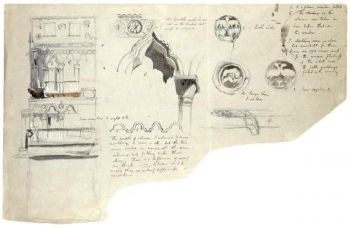
Ruskin was particularly enamored with the architecture of Venice and was vehemently opposed to restoration, so much so that he would climb scaffolding in the Italian city to argue with stonemasons. His convictions were immortalized in The Stones of Venice, a three-volume treatise on Venetian art and architecture, in which he expanded the ideas he had formulated in The Seven Lamps of Architecture (1849), an extended essay in which he argued that the leading principles of architecture were sacrifice, truth, power, beauty, life, memory, and obedience. Within the Stones of Venice was a chapter On the Nature of Gothic, in which Ruskin proposed that architecture revealed the spiritual and moral state of the society that produced it. He admired the Christian society of the Middle Ages and its imperfections which represented the individual craftsman's autonomy and talent, but also that it was communal art, inspired by a love of God. It stood against the regularity and geometrical shapes of the Classical style that to Ruskin represented coldness, a need to control, and a "haughty aristocratic style". For Ruskin, Classical architecture represented a fall from healthy civilization.
Unto This Last (1862)
This work, although a move away from art criticism, was considered by many to be Ruskin's best. Unto This Last took on the thorny issue of capitalist economics, and formed an indictment of the dehumanization caused by the industrial revolution. Passionately written, the work was received with shock as he made a personal plea to his readers to help build a fairer society. He condemned the ugliness of industrialism and the impact commerce was having on the natural world. He also denounced society's dependence on child labor, appealing to employers to ask whether their own children would be asked to do such work.
Unto This Last alienated friends and professional acquaintances alike. Some considered his speech outmoded, others regarded him as self-righteous. One review said reading the book was like being "preached to death by a mad governess", while another stated "if we do not crush [Ruskin], his wild words will touch the springs of action in some hearts and before we are aware, a moral floodgate may fly open and drown us all." The impact of the work, however, cannot be underestimated and he influenced many founders of the British Labour Party as well as the economist John A Hobson. When Mahatma Gandhi read Unto This Last, it inspired him to become an activist, and he translated it into Gujarati so that it may be read by the working classes of India. Gandhi wrote: "I believe that I discovered some of my deepest convictions reflected in this great book of Ruskin and that is why it so captured me and made me transform my life."
The Marriage to Effie

In 1848 Ruskin married the beautiful Euphemia Gray (known as Effie), a family friend who was ten years his junior. It was a disaster as Ruskin failed to accommodate the young woman's interests or overcome the dominant presence of his own mother. One of the best-known stories about the marriage is that it was never consummated. Legend has it that Ruskin was unable to perform on his wedding night because he was so shocked by the revelation that his young wife had pubic hair, unlike the women in paintings he had grown up admiring. The story is most likely apocryphal, but Effie claimed her husband "had imagined women were quite different to what he saw I was, and that the reason he did not make me his wife was because he was disgusted with my person the first evening". This sentiment was echoed by Ruskin who stated that "It may be thought strange that I could abstain from a woman who to most people was so attractive. But though her face was beautiful, her person was not formed to excite passion. On the contrary, there were certain circumstances in her person which completely checked it". Ruskin's friend Clive Wilmer said: "The poor man had a bad marriage, but it takes two to make a bad marriage. He had faults, which one shouldn't pretend weren't there - he was very dogmatic...he could be quite arrogant - but he was extremely knowledgeable."
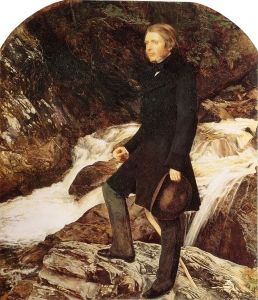
In 1852 Effie met John Everett Millais and modelled for one of his paintings, The Order of Release. Millais then accompanied the couple on a trip to Scotland to paint Ruskin. During this period Effie and he fell in love. Returning to London, Effie left Ruskin and filed for an annulment. Despite causing a major public scandal, in 1854 the marriage was annulled on the grounds of "incurable impotency". The following year Effie married Millais and they went onto to have eight children together. In 2014 the scandal was made into a movie, Effie Gray, starring Emma Thompson.
Around 1865 Ruskin fell in love with Rose La Touche (on who he based his 1865 book Sesame and Lillies), a young pupil, to whom he proposed. Her parents refused permission after corresponding with Effie. The following year, Ruskin renewed his proposal when Rose turned 18 (by which time he was 47) and could legally make her own decision, but she, again, refused. Rose died in 1875, at the age of 27, reportedly of anorexia, and Ruskin was heartbroken. He was haunted by Rose's death, turning to spiritualism to contact her. During this period, he started to show the first signs of the serious psychological distress that would haunt him for the rest of his life.
Late Years and Death
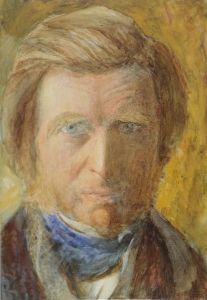
In 1869 Ruskin was made Slade Professor of Fine Art at Oxford. This was not Ruskin's first teaching role, he had been involved in education in a range of capacities from the 1850s and was a very popular lecturer. In 1871 he set up his own art school, The Ruskin School of Drawing and Fine Art which sought to challenge formal methods and rigid, mechanical teaching systems. He also promoted the virtues of public service and manual labor. Ruskin endowed the school with £5000 of his own money. In 1879 Ruskin resigned from Oxford, but resumed his Professorship in 1883, resigning again the following year, this was probably due to conflict with the University authorities, who refused to expand his Drawing School as well as his increasing ill health. During this period he continued to put his political thoughts into practice, writing the monthly magazine Fors Clavigera, aimed at "workmen and labourers" and founding the Guild of St George, a utopian society which encouraged traditional crafts and amassed a large collection of art, books, and historical objects. He also wrote a number of travel guides including Mornings in Florence (1875-77) and The Bible of Amiens (1880-85)
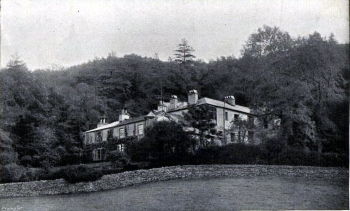
In 1871 he bought Brantwood, a house in the Lake District which stands today as a museum of Ruskin's work. He lived there for the rest of his life enjoying the simplicities of home decoration, gardening and baking. From the late-1870s he had bouts of deep depression and underwent episodes of crisis which may have been a symptom of bipolar disorder. He was cared for by his second cousin, Joan Severn, who inherited his estate after his death. In 1878 he became convinced that his beloved Rose had returned from the dead, crying out in delirium for "Rosie-Posie" and shouting "Everything white! Everything black!". He died from influenza at the age of 80 in 1900, leaving little money behind. He had inherited at least £120,000 from his father but had given most of it away.
The Legacy of John Ruskin
Ruskin's writing was responsible for shaping and promoting the Pre-Raphaelite Brotherhood and the Arts and Crafts Movement. His style of art criticism was groundbreaking and hugely influential to subsequent generations. As novelist Michael Bracewell writes: "Ruskin's passionate championing of particular artists paved the way for such great later critics as David Sylvester and Robert Hughes. Such erudition, clarity and richly opinionated rigor is sorely missed in contemporary art criticism." Ruskin was also respected by legendary writers including Marcel Proust, Charlotte Brontë. And Leo Tolstoy remarked after the critic's death: "John Ruskin was one of the most remarkable men not only of England and our time, but all countries and all time."
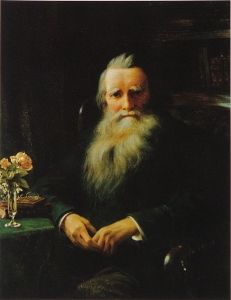
Beyond his writing and artistic talent, it was his radical ideas that really brought about change. As William Morris said: "He seemed to point out a new road on which others should travel" and Ruskin's social conscience was instrumental in improving society in Britain and abroad. He promoted women's education and carried out lectures to laborers which would go on to improve conditions for the working classes. He spent his own money setting up the Guild of St George which provided land where people could work cooperatively. The guild is now a charity for arts, crafts, and the rural economy. Furthermore, the introduction of garden cities have been attributed to Ruskin, and it was his love for the Lake District that ignited a drive to protect and conserve the landscape and sparked the foundation of the National Trust. His ideas also helped found the Welfare State in Britain - an institution that saw free health care for all, the introduction of a minimum wage and allowances for the vulnerable.
Ruskin continues to fascinate today, 200 years after his birth. As art historian Daisy Dunn notes: "Ruskin was a man of intense contradictions. Like a fish, he said, it is healthiest to swim against the stream. He described himself mostly as a Conservative, but many of his ideas were socialist in outlook. He believed in hierarchy but also that the rich had a responsibility to protect the poor." He has even been credited with foreseeing the horrors of climate change. In his book The Storm-Cloud of the Nineteenth Century he predicted "a period which will assuredly be recognized in future meteorological history as one of phenomena hitherto unrecorded in the courses of nature." As literary historian Marcus Waithe said: "Ruskin's dark premonition of atmospheric pollution...has been largely vindicated. Concerns about plastic pollution in our oceans likewise echo his fretful attention to the cleanliness of rivers and the purity of springs."
Influences and Connections

- William Wordsworth
- Lord Byron
- Sir Walter Scott
-
![William Morris]() William Morris
William Morris -
![J.M.W. Turner]() J.M.W. Turner
J.M.W. Turner - Thomas Carlyle
-
![William Morris]() William Morris
William Morris - Mahatma Gandhi
- Leo Tolstoy
-
![Oscar Wilde]() Oscar Wilde
Oscar Wilde -
![Dante Gabriel Rossetti]() Dante Gabriel Rossetti
Dante Gabriel Rossetti -
![John Everett Millais]() John Everett Millais
John Everett Millais - Thomas Carlyle
-
![The Pre-Raphaelites]() The Pre-Raphaelites
The Pre-Raphaelites -
![Arts and Crafts Movement]() Arts and Crafts Movement
Arts and Crafts Movement -
![Art Nouveau]() Art Nouveau
Art Nouveau - American Landscape Painting
Useful Resources on John Ruskin
- John RuskinOur PickBy Tim Hilton
- John Ruskin: Artist and ObserverBy Christopher Baker
- Masters: John Ruskin and His Influence on American ArtBy John A. Parks
- Ruskin, Turner & the Storm CloudBy Suzanne Fagence Cooper
- The Genius of John Ruskin: Selections from His WritingsBy John D. Rosenberg
- The Worlds of John RuskinBy Kevin Jackson
- Unto this last - 200 years of John RuskinBy Tara Contractor
